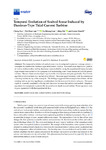Temporal Evolution of Seabed Scour Induced by Darrieus-Type Tidal Current Turbine
| dc.contributor.author | Sun, | |
| dc.contributor.author | Lam, | |
| dc.contributor.author | Lam, | |
| dc.contributor.author | Dai, Yong Ming | |
| dc.contributor.author | Hamill, | |
| dc.date.accessioned | 2019-05-29T15:51:10Z | |
| dc.date.available | 2019-05-29T15:51:10Z | |
| dc.date.issued | 2019-04-28 | |
| dc.identifier.issn | 2073-4441 | |
| dc.identifier.issn | 2073-4441 | |
| dc.identifier.other | ARTN 896 | |
| dc.identifier.uri | http://hdl.handle.net/10026.1/14223 | |
| dc.description.abstract |
<jats:p>The temporal evolution of seabed scour was investigated to prevent damage around a monopile foundation for Darrieus-type tidal current turbine. Temporal scour depths and profiles at various turbine radius and tip clearances were studied by using the experimental measurements. Experiments were carried out in a purpose-built recirculating water flume associated with 3D printed turbines. The scour hole was developed rapidly in the initial process and grew gradually. The ultimate equilibrium of scour hole was reached after 180 min. The scour speed increased with the existence of a rotating turbine on top of the monopile. The findings suggested that monopile foundation and the rotating turbine are two significant considerations for the temporal evolution of scour. The scour depth is inversely correlated to the tip-bed clearance between the turbine and seabed. Empirical equations were proposed to predict the temporal scour depth around turbine. These equations were in good agreement with the experimental data.</jats:p> | |
| dc.format.extent | 896-896 | |
| dc.language | en | |
| dc.language.iso | en | |
| dc.publisher | MDPI AG | |
| dc.subject | seabed scour | |
| dc.subject | tidal current turbine | |
| dc.subject | ocean renewable energy | |
| dc.title | Temporal Evolution of Seabed Scour Induced by Darrieus-Type Tidal Current Turbine | |
| dc.type | journal-article | |
| dc.type | Journal Article | |
| plymouth.author-url | https://www.webofscience.com/api/gateway?GWVersion=2&SrcApp=PARTNER_APP&SrcAuth=LinksAMR&KeyUT=WOS:000472680400026&DestLinkType=FullRecord&DestApp=ALL_WOS&UsrCustomerID=11bb513d99f797142bcfeffcc58ea008 | |
| plymouth.issue | 5 | |
| plymouth.volume | 11 | |
| plymouth.publication-status | Published online | |
| plymouth.journal | Water | |
| dc.identifier.doi | 10.3390/w11050896 | |
| plymouth.organisational-group | /Plymouth | |
| plymouth.organisational-group | /Plymouth/Faculty of Science and Engineering | |
| plymouth.organisational-group | /Plymouth/Faculty of Science and Engineering/School of Engineering, Computing and Mathematics | |
| plymouth.organisational-group | /Plymouth/PRIMaRE Publications | |
| plymouth.organisational-group | /Plymouth/REF 2021 Researchers by UoA | |
| plymouth.organisational-group | /Plymouth/REF 2021 Researchers by UoA/UoA12 Engineering | |
| plymouth.organisational-group | /Plymouth/Research Groups | |
| plymouth.organisational-group | /Plymouth/Research Groups/Marine Institute | |
| plymouth.organisational-group | /Plymouth/Users by role | |
| plymouth.organisational-group | /Plymouth/Users by role/Academics | |
| dcterms.dateAccepted | 2019-04-25 | |
| dc.rights.embargodate | 2019-11-27 | |
| dc.identifier.eissn | 2073-4441 | |
| dc.rights.embargoperiod | Not known | |
| rioxxterms.versionofrecord | 10.3390/w11050896 | |
| rioxxterms.licenseref.uri | http://www.rioxx.net/licenses/all-rights-reserved | |
| rioxxterms.licenseref.startdate | 2019-04-28 | |
| rioxxterms.type | Journal Article/Review |


